Thapanun Sudhawiyangkul
PseudoCell: Hard Negative Mining as Pseudo Labeling for Deep Learning-Based Centroblast Cell Detection
Jul 06, 2023Abstract:Patch classification models based on deep learning have been utilized in whole-slide images (WSI) of H&E-stained tissue samples to assist pathologists in grading follicular lymphoma patients. However, these approaches still require pathologists to manually identify centroblast cells and provide refined labels for optimal performance. To address this, we propose PseudoCell, an object detection framework to automate centroblast detection in WSI (source code is available at https://github.com/IoBT-VISTEC/PseudoCell.git). This framework incorporates centroblast labels from pathologists and combines them with pseudo-negative labels obtained from undersampled false-positive predictions using the cell's morphological features. By employing PseudoCell, pathologists' workload can be reduced as it accurately narrows down the areas requiring their attention during examining tissue. Depending on the confidence threshold, PseudoCell can eliminate 58.18-99.35% of non-centroblasts tissue areas on WSI. This study presents a practical centroblast prescreening method that does not require pathologists' refined labels for improvement. Detailed guidance on the practical implementation of PseudoCell is provided in the discussion section.
ApSense: Data-driven Algorithm in PPG-based Sleep Apnea Sensing
Jun 19, 2023Abstract:In this paper, we utilized obstructive sleep apnea and cardiovascular disease-related photoplethysmography (PPG) features in constructing the input to deep learning (DL). The features are pulse wave amplitude (PWA), beat-to-beat or RR interval, a derivative of PWA, a derivative of RR interval, systolic phase duration, diastolic phase duration, and pulse area. Then, we develop DL architectures to evaluate the proposed features' usefulness. Eventually, we demonstrate that in human-machine settings where the medical staff only needs to label 20% of the PPG recording length, our proposed features with the developed DL architectures achieve 79.95% and 73.81% recognition accuracy in MESA and HeartBEAT datasets. This simplifies the labelling task of the medical staff during the sleep test yet provides accurate apnea event recognition.
ANet: Autoencoder-Based Local Field Potential Feature Extractor for Evaluating An Antidepressant Effect in Mice after Administering Kratom Leaf Extracts
Sep 17, 2022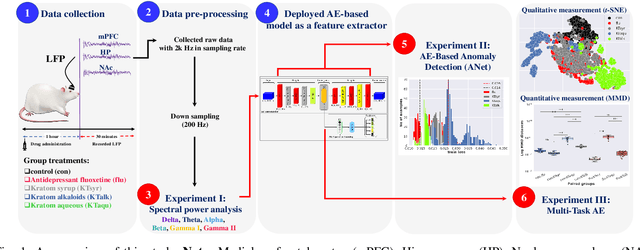
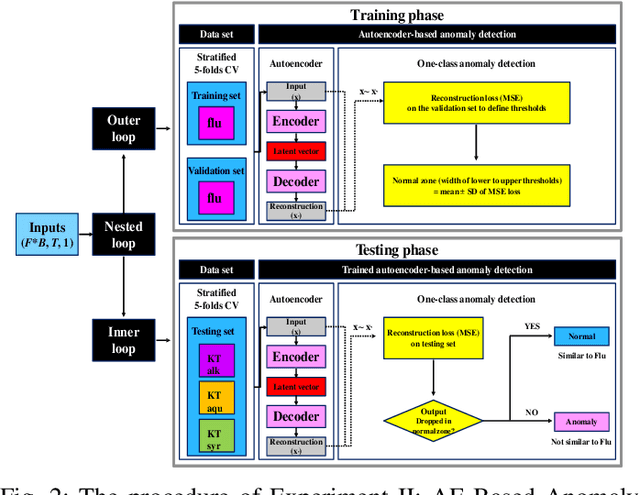

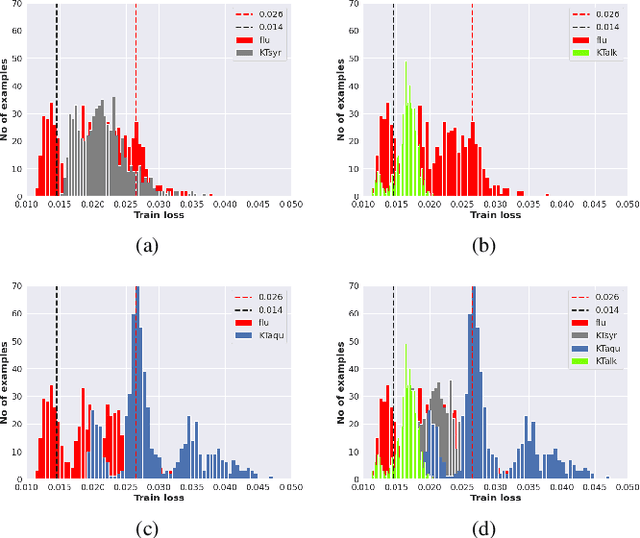
Abstract:Kratom (KT) typically exerts antidepressant (AD) effects. However, evaluating which form of KT extracts possesses AD properties similar to the standard AD fluoxetine (flu) remained challenging. Here, we adopted an autoencoder (AE)-based anomaly detector called ANet to measure the similarity of mice's local field potential (LFP) features that responded to KT leave extracts and AD flu. The features that responded to KT syrup had the highest similarity to those that responded to the AD flu at 85.62 $\pm$ 0.29%. This finding presents the higher feasibility of using KT syrup as an alternative substance for depressant therapy than KT alkaloids and KT aqueous, which are the other candidates in this study. Apart from the similarity measurement, we utilized ANet as a multi-task AE and evaluated the performance in discriminating multi-class LFP responses corresponding to the effect of different KT extracts and AD flu simultaneously. Furthermore, we visualized learned latent features among LFP responses qualitatively and quantitatively as t-SNE projection and maximum mean discrepancy distance, respectively. The classification results reported the accuracy and F1-score of 79.78 $\pm$ 0.39% and 79.53 $\pm$ 0.00%. In summary, the outcomes of this research might help therapeutic design devices for an alternative substance profile evaluation, such as Kratom-based form in real-world applications.
OCTAve: 2D en face Optical Coherence Tomography Angiography Vessel Segmentation in Weakly-Supervised Learning with Locality Augmentation
Jul 25, 2022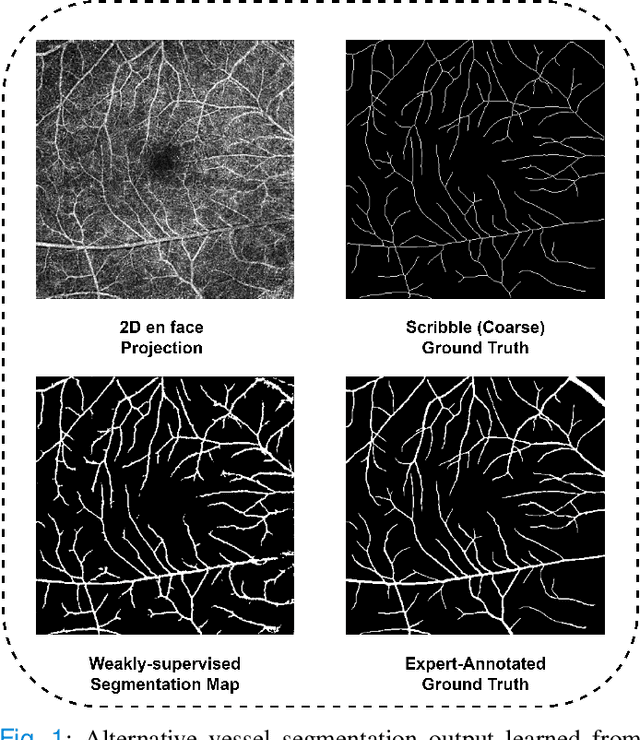
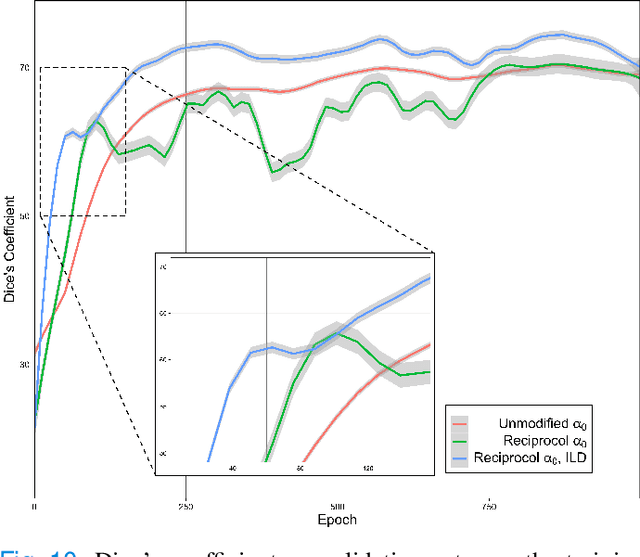
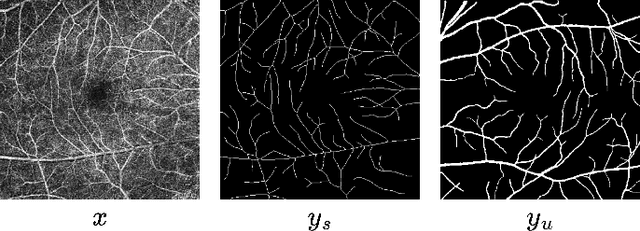

Abstract:While there have been increased researches using deep learning techniques for the extraction of vascular structure from the 2D en face OCTA, for such approach, it is known that the data annotation process on the curvilinear structure like the retinal vasculature is very costly and time consuming, albeit few tried to address the annotation problem. In this work, we propose the application of the scribble-base weakly-supervised learning method to automate the pixel-level annotation. The proposed method, called OCTAve, combines the weakly-supervised learning using scribble-annotated ground truth augmented with an adversarial and a novel self-supervised deep supervision. Our novel mechanism is designed to utilize the discriminative outputs from the discrimination layer of a UNet-like architecture where the Kullback-Liebler Divergence between the aggregate discriminative outputs and the segmentation map predicate is minimized during the training. This combined method leads to the better localization of the vascular structure as shown in our experiments. We validate our proposed method on the large public datasets i.e., ROSE, OCTA-500. The segmentation performance is compared against both state-of-the-art fully-supervised and scribble-based weakly-supervised approaches. The implementation of our work used in the experiments is located at [LINK].
A Pilot Study on Visually-Stimulated Cognitive Tasks for EEG-Based Dementia Recognition Using Frequency and Time Features
Mar 05, 2021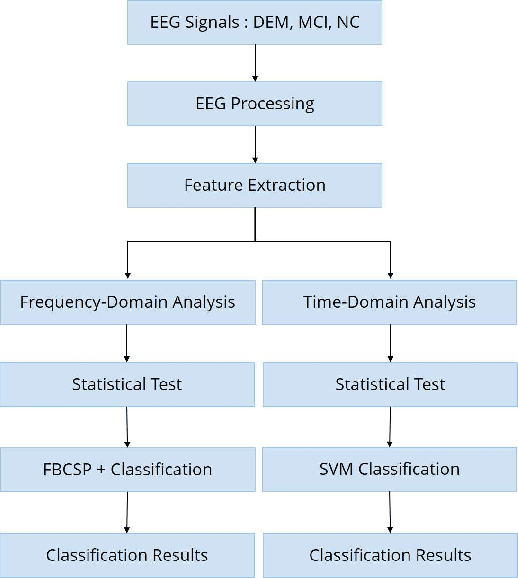
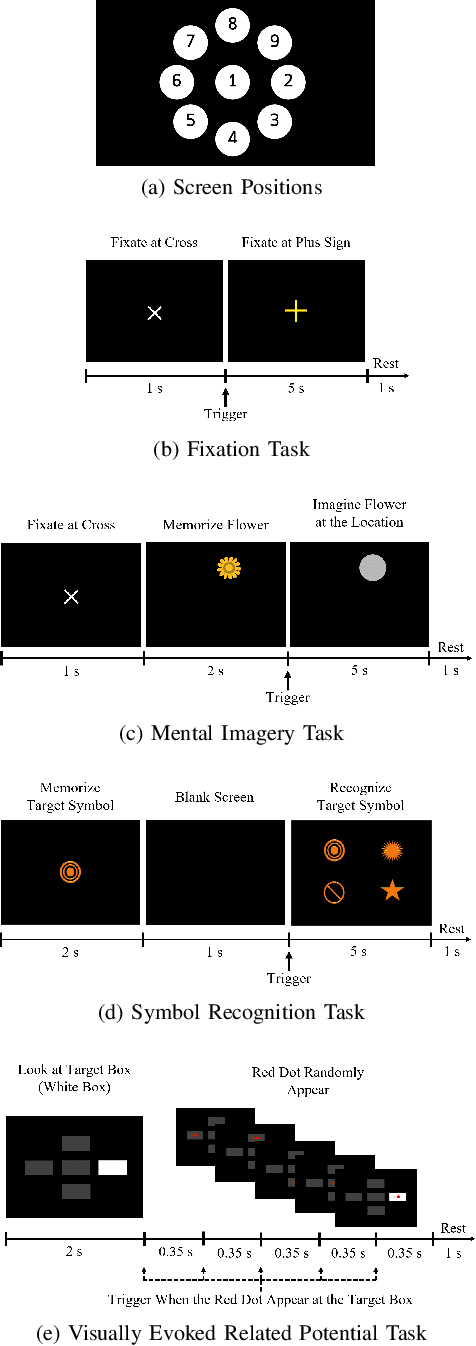
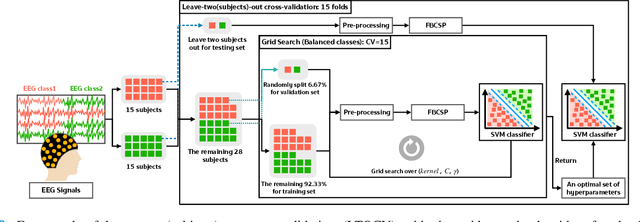
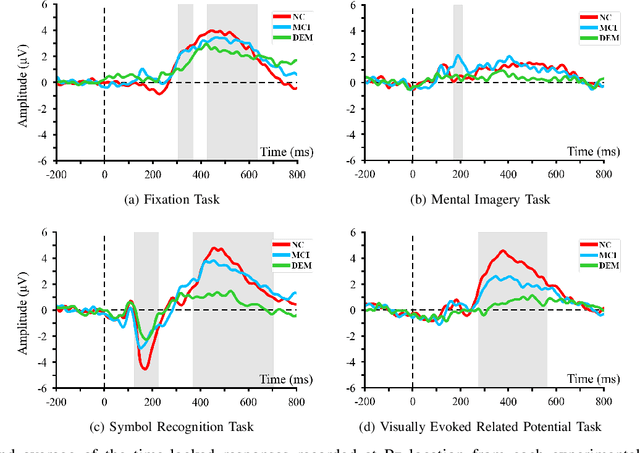
Abstract:Dementia is one of the main causes of cognitive decline. Since the majority of dementia patients cannot be cured, being able to diagnose them before the onset of the symptoms can prevent the rapid progression of the cognitive impairment. This study aims to investigate the difference in the Electroencephalograph (EEG) signals of three groups of subjects: Normal Control (NC), Mild Cognitive Impairment (MCI), and Dementia (DEM). Unlike previous works that focus on the diagnosis of Alzheimer's disease (AD) from EEG signals, we study the detection of dementia to generalize the classification models to other types of dementia. We have developed a pilot study on machine learning-based dementia diagnosis using EEG signals from four visual stimulation tasks (Fixation, Mental Imagery, Symbol Recognition, and Visually Evoked Related Potential) to identify the most suitable task and method to detect dementia using EEG signals. We extracted both frequency and time domain features from the EEG signals and applied a Support Vector Machine (SVM) for each domain to classify the patients using those extracted features. Additionally, we study the feasibility of the Filter Bank Common Spatial Pattern (FBCSP) algorithm to extract features from the frequency domain to detect dementia. The evaluation of the model shows that the tasks that test the working memory are the most appropriate to detect dementia using EEG signals in both time and frequency domain analysis. However, the best results in both domains are obtained by combining features of all four cognitive tasks.
MIN2Net: End-to-End Multi-Task Learning for Subject-Independent Motor Imagery EEG Classification
Feb 07, 2021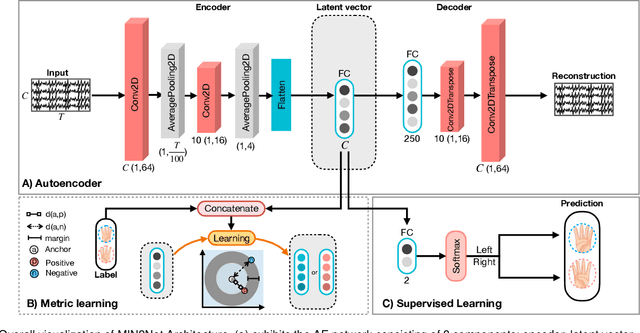
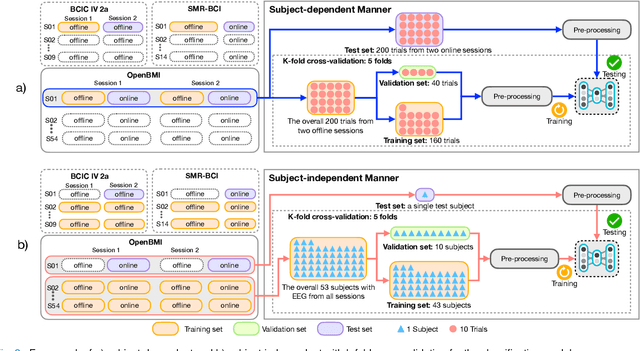
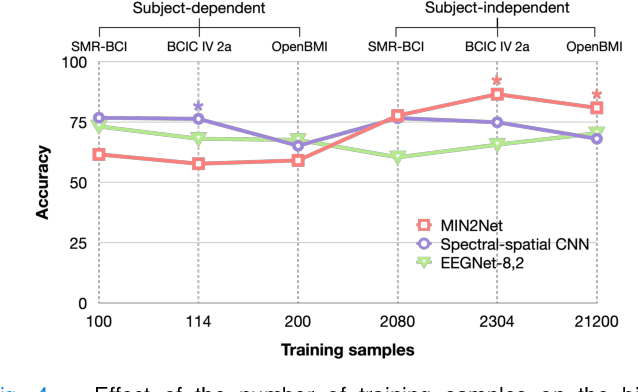
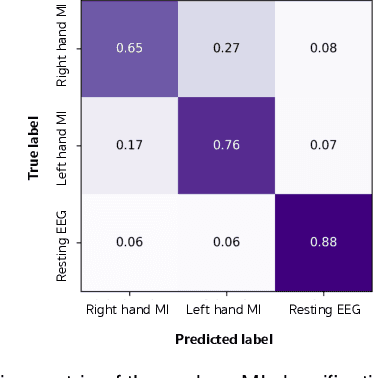
Abstract:Advances in the motor imagery (MI)-based brain-computer interfaces (BCIs) allow control of several applications by decoding neurophysiological phenomena, which are usually recorded by electroencephalography (EEG) using a non-invasive technique. Despite great advances in MI-based BCI, EEG rhythms are specific to a subject and various changes over time. These issues point to significant challenges to enhance the classification performance, especially in a subject-independent manner. To overcome these challenges, we propose MIN2Net, a novel end-to-end multi-task learning to tackle this task. We integrate deep metric learning into a multi-task autoencoder to learn a compact and discriminative latent representation from EEG and perform classification simultaneously. This approach reduces the complexity in pre-processing, results in significant performance improvement on EEG classification. Experimental results in a subject-independent manner show that MIN2Net outperforms the state-of-the-art techniques, achieving an accuracy improvement of 11.65%, 1.03%, and 10.53% on the BCI competition IV 2a, SMR-BCI, and OpenBMI datasets, respectively. We demonstrate that MIN2Net improves discriminative information in the latent representation. This study indicates the possibility and practicality of using this model to develop MI-based BCI applications for new users without the need for calibration.
Revealing Preference in Popular Music Through Familiarity and Brain Response
Jan 30, 2021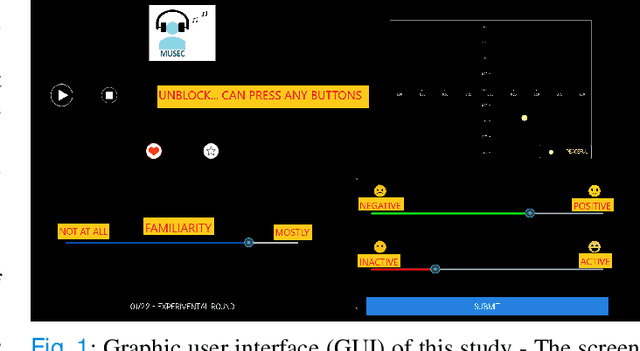
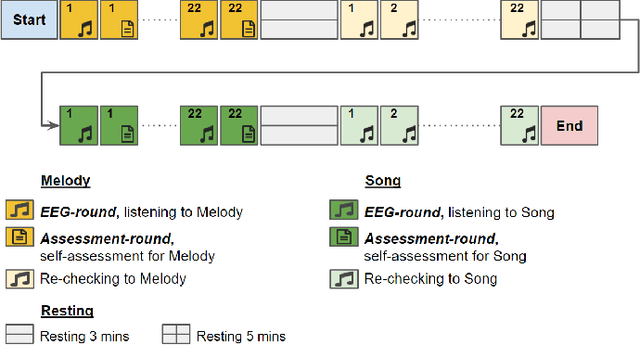
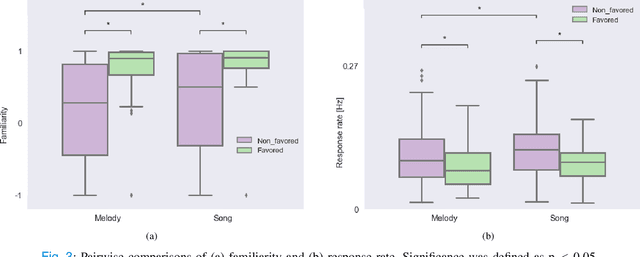
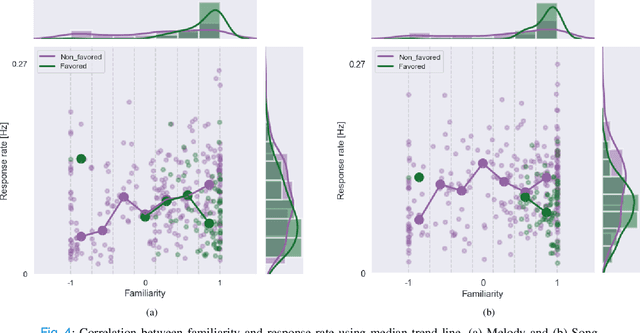
Abstract:Music preference was reported as a factor, which could elicit innermost music emotion, entailing accurate ground-truth data and music therapy efficiency. This study executes statistical analysis to investigate the distinction of music preference through familiarity scores, response times (response rates), and brain response (EEG). Twenty participants did self-assessment after listening to two types of popular music's chorus section: music without lyrics (Melody) and music with lyrics (Song). We then conduct a music preference classification using a support vector machine (SVM) with the familiarity scores, the response rates, and EEG as the feature vectors. The statistical analysis and SVM's F1-score of EEG are congruent, which is the brain's right side outperformed its left side in classification performance. Finally, these behavioral and brain studies support that preference, familiarity, and response rates can contribute to the music emotion experiment's design to understand music, emotion, and listener. Not only to the music industry, the biomedical, and healthcare industry can also exploit this experiment to collect data from patients to improve the efficiency of healing by music.
 Add to Chrome
Add to Chrome Add to Firefox
Add to Firefox Add to Edge
Add to Edge